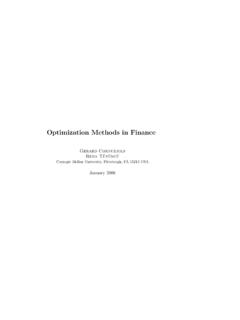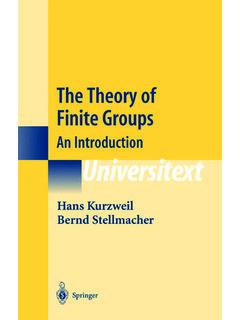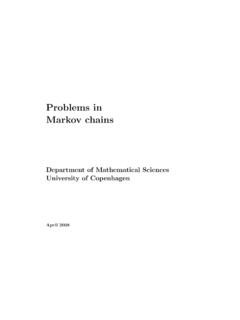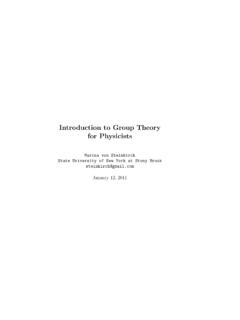Transcription of General Topology Jesper M. M˝ller
1 General TopologyJesper M. M llerMatematisk Institut, Universitetsparken 5, DK 2100 K benhavnE-mail 0. Introduction5 Chapter 1. Sets and maps71. Sets, functions and relations72. The integers and the real numbers113. Products and coproducts134. Finite and infinite sets145. Countable and uncountable sets166. Well-ordered sets187. Partially ordered sets, The Maximum Principle and Zorn s lemma19 Chapter 2. Topological spaces and continuous maps231. Topological spaces232. Order topologies253. The product topology254. The subspace topology265. Closed sets and limit points296. Continuous functions327. The quotient topology368. Metric topologies439. Connected spaces4610. Compact spaces5211. Locally compact spaces and the Alexandroff compactification58 Chapter 3. Regular and normal spaces631. Countability Axioms632.
2 Separation Axioms643. Normal spaces664. Second countable regular spaces and the Urysohn metrization theorem685. Completely regular spaces and the Stone Cech compactification716. Manifolds73 Chapter 4. Relations between topological spaces75 Bibliography773 CHAPTER 0 IntroductionThese notes are intended as an to introduction General Topology . They should be sufficient for furtherstudies in geometry or algebraic from readers are welcome. Thanks to Micha l Jab lonowski and Antonio D az Ramos forpointing out misprinst and errors in earlier versions of these 1 Sets and mapsThis chapter is concerned with set theory which is the basis of all mathematics. Maybe it even canbe said that mathematics is the science of sets. We really don t know what a set is but neither do thebiologists know what life is and that doesn t stop them from investigating Sets, functions and set is a collection of mathematical objects.
3 We writea Sif the setScontains natural numbers 1,2,3,..can be collected to form the setZ+={1,2,3,..}.This na ve form of set theory unfortunately leads to s paradox1concerns theformulaS6 S. First note that it may well happen that a set is a member of itself. The set of all infinitesets is an example. The Russel setR={S|S6 S}is the set of all sets that are not a member of itself. IsR Ror isR6 R?How can we remove this contradiction? universe of mathematical objects is stratified. Level0of the universe consistsof (possibly) someatomicobjects. Leveli >0consists of collections of objects from lower levels. A set isa mathematical object that is not object of the universe can satisfyS Sfor atoms do not have elements and a set and an elementfrom that set can not be in the same level. ThusRconsists of everything in the universe. Since theelements ofRoccupy all levels of the universe there is no level left forRto be in.
4 ThereforeRis outsidethe universe,Ris not a set. The contradiction has evaporated!Axiomatic set theory is an attempt to make this precise formulating a theory based on axioms, theZFC-axioms, for set theory. (Z stands for Zermelo, F for Fraenkel, and C for Axiom of Choice.) It is notpossible to prove or disprove the statement ZFC is consistent within ZFC that is within mathematics[12].IfAandBare sets thenA B={x|x Aandx B}A B={x|x Aorx B}A B={(x,y)|x Aandy B}AqB={(1,a)|a A} {(2,b)|b B}andA B={x|x Aandx6 B}are also sets. These operations satisfyA (B C) = (A B) (A C)A (B C) = (A B) (A C)A (B C) = (A B) (A C)A (B C) = (A B) (A C)as well as several other say thatAis a subset ofB, orBa superset ofA, if all elements ofAare elements ofB. ThesetsAandBare equal ifAandBhave the same elements. In mathematical symbols,A B x A:x BA=B ( x A:x Band x B:x A) A BandB AThepower setofA,P(A) ={B|B A}is the set of all subsets a person says I am lying is he lying?
5 781. SETS AND or maps are fundamental to all of mathematics. So what is a function? function fromAtoBis a subsetfofA Bsuch that for allainAthere isexactly onebinBsuch that(a,b) writef:A Bfor the functionf A Band think offas a rule that to any elementa Aassociates a unique objectf(a) B. The setAis the domain off, the setBis the codomain off;dom(f) =A, cod(f) = functionfis injectiveorone-to-oneif distinct elements ofAhave distinct images inB, surjectiveorontoif all elements inBare images of elements inA, bijectiveif both injective and surjective, if any element ofBis the image of precisely one other words, the mapfis injective, surjective, bijective iff the equationf(a) =bhas at most onesolution, at least one solution precisely one solution, for allb :A Bandg:B Care maps such that cod(f) = dom(g), then the composition is the mapg f:A Cdefined byg f(a) =g(f(a)).
6 Two sets.(1)Letf:A Bbe any map. Thenfis injective fhas a left inversefis surjectiveAC fhas a right inversefis bijective fhas an inverse(2)There exists a surjective mapA BAC There exits an injective mapB ATwo of the statements in Proposition require the Axiom of Choice ( ).Any left inverse is surjective and any right inverse is :A Bis bijective then the inversef 1:B Ais the map that tob Bassociates the uniquesolution to the equationf(a) =b, iea=f 1(b) f(a) =bfor alla A,b map(A,B) denote the set of all maps fromAtoB. Thenmap(X,A B) = map(X,A) map(X,B),map(AqB,X) = map(A,X) map(B,X)for all setsX,A, andB. Some people like to rewrite this asmap(X,A B) = map( X,(A,B)),map(AqB,X) = map((A,B), X)Here, (A,B) is a pair of spaces and maps (f,g) : (X,Y) (A,B) between pairs of spaces are defined tobe pairs of mapsf:X A,g:Y B. The diagonal, X= (X,X), takes a spaceXto the pair (X,X).
7 These people say that the product is right adjoint to the diagonal and the coproduct is left adjoint tothe are many types of relations. We shall here concentrate on equivalence rela-tions and order relationRon the setAis a subsetR A may define a relationDonZ+byaDbifadividesb. The relationD Z+ Z+has the properties thataDafor allaandaDbandbDc= aDcfor alla,b,c. We say thatDis reflexiveand is a typical equivalence relation. Here is the General equivalence relation on a setAis a relation A Athat isReflexive:a afor alla ASymmetric:a b= b afor alla,b ATransitive:a bandb c= a cfor alla,b,c A1. SETS, FUNCTIONS AND RELATIONS9 Theequivalence classcontaininga Ais the subset[a] ={b A|a b}of all elements ofAthat are equivalent toa. There is a canonical map [ ] :A A/ onto the setA/ ={[a]|a A} P(A)of equivalence classes that takes the elementa Ato the equivalence class [a] A/ mapf:A Bis said to respect the equivalence relation ifa1 a2= f(a1) =f(a2) foralla1,a2 A(fis constant on each equivalence class).
8 The canonical map [ ] :A A/ respects theequivalence relation and it is the universal example of such a map: Any mapf:A Bthat respects theequivalence relation factors uniquely throughA/ in the sense that there is a unique mapfsuch thatthe diagramAf//[ ] AAAAAAABA/ !f>>}}}}}}}commutes. How would you definef? (1) Equality is an equivalence relation. The equivalence class [a] ={a}containsjust one element.(2)amodbmodnis an equivalence relation onZ. The equivalence class [a] =a+nZconsists of allintegers congruent toamodnand the set of equivalence classes isZ/nZ={[0],[1],..,[n 1]}.(3)x ydef |x|=|y|is an equivalence relation in the planeR2. The equivalence class [x] is a circlecentered at the origin andR2/ is the collection of all circles centered at the origin. The canonical mapR2 R2/ takes a point to the circle on which it lies.(4) Iff:A Bis any function,a1 a2def f(a1) =f(a2) is an equivalence relation onA.
9 Theequivalence class [a] =f 1(f(a)) Ais the fibre overf(a) B. we writeA/ffor the set of equivalenceclasses. The canonical mapA A/ftakes a point to the fibre in which it lies. Any mapf:A Bcanbe factoredAf//[ ]!!!!BBBBBBBBBA/f==f=={{{{{{{as the composition of a surjection followed by an injection. The corestrictionf:A/f f(A) offis abijection between the set of fibresA/fand the imagef(A).(5) [Ex ] (Restriction) LetXbe a set andA Xa subset. Declare any two elements ofAto beequivalent and any element outsideAto be equivalent only to itself. This is an equivalence relation. Theequivalence classes areAand{x}forx X A. One writesX/Afor the set of equivalence classes.(6) [Ex ] (Equivalence relation generated by a relation) The intersection of any family of equivalencerelations is an equivalence relation. The intersection of all equivalence relations containing a given relationRis called the equivalence relation generated be an equivalence relation on a setA.}}}}}}}
10 Then(1)a [a](2) [a] = [b] a b(3)If[a] [b]6= then[a] = [b]Proof.(1) is reflexivity, (2) is symmetry , (3) is transitivity : Ifc [a] [b], thena c bsoa band [a] = [b] by (2). This lemma implies that the setA/ P(A) is apartitionofA, a set of nonempty, disjoint subsetsofAwhose union is all ofA. Conversely, given any partition ofAwe define an equivalence relation bydeclaringaandbto be equivalent if they lie in the same subset of the partition. We conclude that anequivalence relation is essentially the same thing as a SETS AND usual order relation<onZorRis an example of a linear order. Here isthe General linear order on the setAis a relation< A Athat isComparable:Ifa6=bthena < borb < afor alla,b ANonreflexive:a < afor noa ATransitive:a < bandb < c= a < cfor alla,b,c AWhat are the right maps between ordered sets? (A,<)and(B,<)be linearly ordered sets. Anorder preservingmap is a mapf:A Bsuch thata1< a2= f(a1)< f(a2)for alla1,a2 A.












